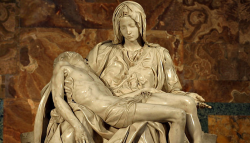Every student who takes art history courses will sooner or later be assigned the task of writing a research paper. Sometimes your professor may assigned the specific topic you write on, but at other times you are responsible for formulating your own research idea. Developing this idea can make or break your entire paper; a bad idea can lead to nights of frustration and a weak thesis, and a great idea can lead to an exciting paper which not only motivates you to study the topic now, but also in future classes, and perhaps even into graduate school. So how does one go about developing a research idea in art history? Here are a few ways to begin a hypothetical 10-page paper:
The book report
Pick a single topic (work of art, building, artist, patron, etc.) that you are not terribly familiar with, and write five pages about it, answering basic questions about historical, artistic, and/or social context. Because you are not starting out with any unusual theory or compelling argument, this approach may seem unexciting or even bland. However, by the time you finish writing the first several pages on this topic, you will likely have gained new insights into the topic that you would not have learned had you simply skimmed the material on the topic. In the remaining 5+ pages on the topic you still need to write, expound upon some interesting aspect that you discovered and wrote about in the first five pages. The strength of this approach is that it requires you to master a single topic before you comment intelligently on it, thereby making your overall paper all the more convincing.
Comparing two or more topics in the same paper
This is similar to the book report, except the purpose is to compare and contrast at least two works/buildings/artists and draw conclusions from them. For example, you could compare Andrea del Castagno’s painting of the Last Supper (c. 1447) with Leonardo da Vinci’s painting (1495-98) of the same subject. How did the interpretation of this scene change over fifty years? How did it remained the same? Or, you could compare three different state-built churches in a particular city within a particular time period. How did each reflect the attitudes of the government of its time? The possibilities for this kind of paper can be endless.
The unknown answer
Pose a question that is out of the ordinary and that you do not know the answer to, and attempt to answer it. For example – “How did Leonardo da Vinci treat food in his art?” Or, “How did Italian artists develop painted shadows during the fifteenth century?” Or, “Was Michelangelo influenced more by Roman or Greek art?” The trick is to formulate a distinct question that leads your investigation. Make sure that your question is open-ended enough that the answer isn’t overly-simple, but narrow enough that you are tackling a topic that can be addressed in a paper of this size. If you find the answer is too simple, consider researching the development of the issue. If you find the answer is impossible to discover without writing a dissertation, write a paper explaining the limits of our knowledge, and potential ways to find answers.
The ready-made topic
If you cannot come up with your own topic, ask your professor or instructor for some ideas. Any decent professor will make time available for students, and particularly for students who need help generating topic ideas. To make the most of your time, approach him or her with some preferences in mind. For example, would you like to write your paper on painting, sculpture, or architecture? Are you interested in the works from a particular time period (e.g. late 1300s, early 1500s, etc.) or a particular region (e.g. Florence, Venice, Siena, etc.)? Do you have an artist or subject matter in mind on which you would like to focus? If you have some preliminary preparation before meeting with your professor, he or she will likely be better able to help you and will appreciate the work that you have already undertaken. After deciding on a topic, make sure to ask for the titles of a few key books or articles you should consult to help you get started.
Note: be careful about writing a paper on the same topic as your professor’s dissertation or other primary area of focus. Not only might your paper prove to be inadequate by your professor’s understandably high standards, but you could be given an overabundance of ideas, issues, or resources to deal with when you simply want to write a manageable paper.
Preparing for success
A research paper can be a nightmare, but it really doesn’t have to be. By planning out a good topic in advance, you set yourself up for less stress, better grades, and overall success.



